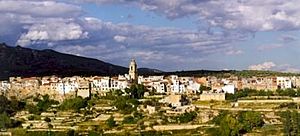La Sénia facts for kids
Quick facts for kids
La Sénia
|
||
|---|---|---|
 |
||
|
||
| Country | ||
| Autonomous Community | ||
| Province | Tarragona | |
| Comarca | Montsià | |
| Area | ||
| • Total | 108.41 km2 (41.86 sq mi) | |
| Elevation | 369 m (1,211 ft) | |
| Population
(2023)
|
||
| • Total | 5,623 | |
| • Density | 51.868/km2 (134.337/sq mi) | |
| Demonym(s) | senienc (catalan), ceniense (spanish) | |
| Postal code |
43560
|
|
La Sénia is a town and municipality in the province of Tarragona. It is located in Catalonia, Spain. The town is part of the Montsià region. For many years, La Sénia has been famous for its furniture industry.
Contents
What's in a Name?
The name La Sénia comes from an Arabic word, saniya. This word means "flour mill" or "water wheel". Over time, it changed into the Romance word azenia. The town shares its name with the Cenia river, which flows nearby.
A Look Back in Time
Early Humans in La Sénia
People have lived in the La Sénia area for a very long time. Scientists have found ancient remains that prove this. In caves like dels Rossegadors and de la Tenalla, you can see old rock art. These paintings show animals and people from the past. They tell us about small groups of humans who moved around seasonally.
Medieval Times and Beyond
The land around the Cenia river was controlled by the Knights Hospitaller starting in 1178. They were a powerful group. La Sénia, then called Cenia, officially became a town on April 17, 1232.
Later, during the Catalan Civil War in 1462, La Sénia fought against King John II of Aragon. The town was attacked many times by royal troops. It finally surrendered in June 1466. In 1716, after the War of Spanish Succession, the town lost many of its special rights. This happened because of new laws called the Nueva Planta decrees.
Modern History of La Sénia
During the Peninsular War (a war against France), La Sénia was important for building ships. When the French left, the old system of kings returned to Spain.
In 1833, Spain was divided into provinces. La Sénia became part of Tarragona. Around this time, a conflict called the First Carlist War began. General Ramón Cabrera took control of the town. It was then attacked many times until 1840.
In 1871, a special noble title was created: the Marquesado de la Cenia. This title was given to Fernando Cotoner y Chacón. By 1907, the town had electricity.
During the Spanish Civil War (1936-1939), an air base was built near La Sénia. It was called els Plans. At first, planes from the Republican Air Force used it. Later, German forces used it as a major base. In December 1938, Republican bombers attacked the base. They damaged German planes and buildings. This was a very daring attack by the Republican Air Force.
In the 1980s, the town's official name changed. It was translated into Catalan. Since then, it has been known as La Sénia.
Culture and Traditions
The main church in La Sénia is dedicated to Saint Bartholomew and Saint Roque. It was built between the 17th and 18th centuries. It has a Baroque style with neoclassical touches. The old part of the village still looks very traditional. Its houses have large doorways and balconies.
In 1904, a music group called Banda Harmónica de Cenia was formed. Today, it is known as Agrupació Musical Senienca. This group has won awards in international music competitions. In 2002, they received the Creu de Sant Jordi, a very important award.
La Sénia's main festival is in August. It is famous for its exciting horse races. In September, people make a special trip to the sanctuary of the Virgin of Pallerols. This sanctuary is on top of Pallerols mountain. It holds an image of the Virgin of Palleróos, who is the patron saint of the town.
Economy and Industry
The economy of La Sénia used to be mostly about farming. Farmers grew olive trees, vineyards, and cereals without much water. In the 1930s, the first brush factories opened.
In the 1960s, the Ulldecona Dam was built. This brought new workers and helped the town's industry grow. Factories for paper, furniture, and other goods were set up.
The olive oil from La Sénia is very special. It comes from very old olive trees. This oil is sold as a luxury product.
The furniture industry is very important in La Sénia. Small furniture workshops started in the 1940s and 1950s. By the 1960s, larger factories were built. Today, most people in La Sénia work in the wood, furniture, and related industries. La Sénia is now a top producer of modern furniture in Spain. It is also a leader in the industry in Catalonia. The town has a special center for furniture technology. It has also been recognized as an important center for handmade furniture.
Sister Cities
- Cazorla, Andalusia
See also
 In Spanish: Cenia para niños
In Spanish: Cenia para niños




